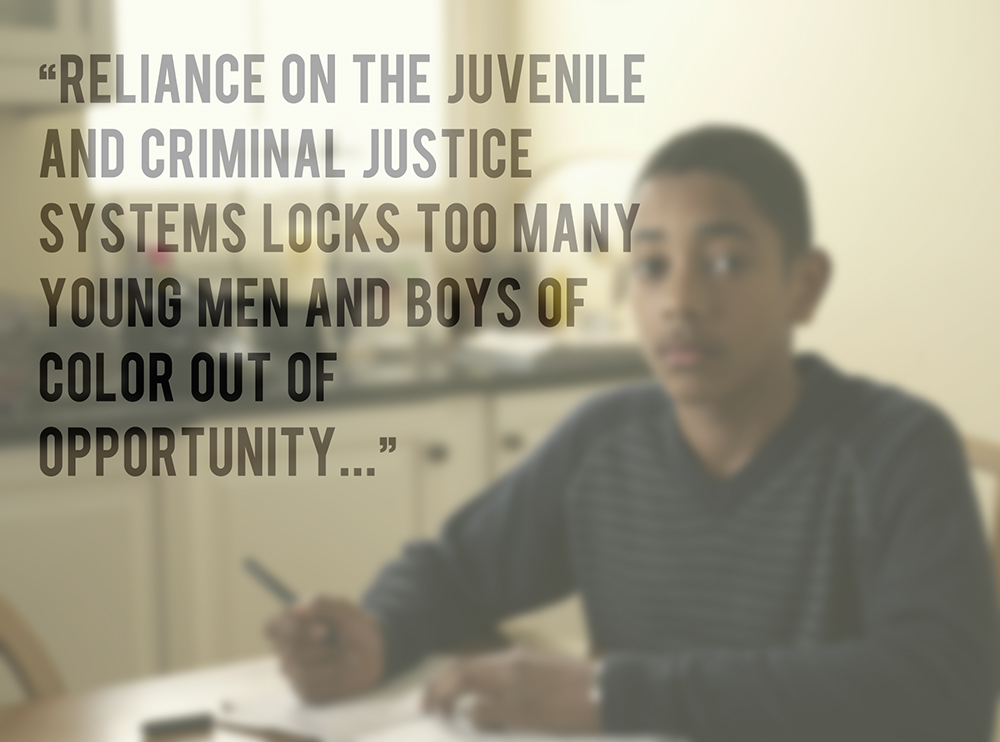 Eleven major foundations have pledged to spend a total of nearly $200 million for efforts to help boys and young men of color succeed, in concert with President Barack Obama’s “My Brother’s Keeper” initiative.
Eleven major foundations have pledged to spend a total of nearly $200 million for efforts to help boys and young men of color succeed, in concert with President Barack Obama’s “My Brother’s Keeper” initiative.
The foundations said in a 12-page executive summary to a still-unreleased report that the funds are to spent over the next three years – what they hope will be the “first steps in what will be longstanding commitments from these and other funders.”
Not all 11 foundations are helping fund all the efforts.
The biggest chunk of the funds, more than $81 million, is to go toward “comprehensive reforms needed to dramatically reduce racial and ethnic disparities in, and the overall use of, confinement for boys and young men,” the executive summary said.
“Reliance on the juvenile and criminal justice systems locks too many young men and boys of color out of opportunity before they fully have a chance to start on the path to adulthood.”
The executive summary provided little detail on specifically how the money is to be spent for that or other efforts.
The full report, “A Time for Action: Mobilizing Philanthropic Support for Boys and Young Men of Color,” is expected to be released this fall.
 In February, Obama announced the “My Brother’s Keeper” initiative to help boys and young men of color.
In February, Obama announced the “My Brother’s Keeper” initiative to help boys and young men of color.
“The My Brother’s Keeper piece served as a catalyst for [the foundations’ funding commitment] … and sparked a new sense of urgency and focus for these foundations in ways that you probably wouldn’t have seen happen so quickly otherwise,” said Damon Hewitt, a senior adviser at the Open Society Foundations, one of the 11 philanthropic foundations.
“We’re all in conversation with each other, which is the really important piece … because I think this is so powerful,” Hewitt told Youth Today.
He said the foundations had been working on some of the initiatives to help boys and young men of color for more than a year before the White House announced My Brother’s Keeper.
“The beauty of what the White House has done [through My Brother’s Keeper] is it helped the stars align and make some big things possible by focusing energies and commitments,” Hewitt said.
A White House task force on My Brother’s Keeper released a report on the initiative to Obama on May 30.
At the time, the 11 philanthropies released a joint statement saying, in part, “The report’s emphasis on early childhood support, improving literacy, creating greater pathways to college and career success, and reducing unnecessary involvement with the justice system are all key factors toward improving the lives of boys and young men of color.”
The statement noted the 11 foundations joined forces in February to provide a private-sector counterpart to the My Brother’s Keeper initiative.
“Our commitment to fundamentally improving the life trajectory of young men of color is unwavering, and it is essential to build on this momentum to improve the policies and structures that currently impede the ability of many young men to participate fully in American society,” the statement said.
The foundations’ executive summary also outlined other funding:
- More than $55 million will to go toward “an unprecedented partnership to accelerate efforts to reduce suspensions, expulsions, school-based arrests and juvenile court referrals in our nation’s elementary and secondary public schools and pre-school settings.” Among other things, this funding is designed to spur further efforts by the public and private sectors to reduce racial disparities in school discipline.
- More than $26 million is to be spent on efforts to help supplant negative portrayals of boys and young men of color with positive ones in print, broadcast and social media. These funds are meant to “lift up positive narratives that affirm the value of all human beings, including boys and men of color, and to minimize the effect of implicit bias.”
- More than $21 million is intended to “catalyze matching funds from other national and community foundations, corporations, and public/private partnerships to build on existing local efforts and infrastructure that offer promise of success … to help communities develop and/or expand strategies explicitly aimed at reducing disparities and improving life outcomes for boys and young men of color.”
- A seed investment of more than $11 million is to spin off the Campaign for Black Male Achievement, now part of the Open Society Foundations, as an independent entity.
Along with the Open Society Foundations, the other philanthropies that have contributed to the funding are the Annie E. Casey Foundation, The Atlantic Philanthropies, Bloomberg Philanthropies, The California Endowment, the Ford Foundation, the John S. & James L. Knight Foundation, the Kapor Center for Social Impact, The Nathan Cummings Foundation, the Robert Wood Johnson Foundation and the W.K. Kellogg Foundation.


My Brother’s Keeper’ initiative is destroying the Black male mentoring movement
by Phillip Jackson
The White House’s “My Brother’s Keeper” initiative is destroying the Black Male Mentoring Movement in America—decades-long work to save Black boys. Virtually all of the small, community-based agencies that comprise this substantial, historic effort to mentor Black boys have been left out of the overall conversation, the planning, and the funding essential to save Black boys and to chart a new course for their continued survival. Many of these groups provided mentoring for Black boys long before President Barack Obama became president and they will be working to save Black boys when he leaves the office.
The White House made a strange decision to allow The University of Chicago to be its lead academic partner in the mentoring of Black boys although no visible plan exists to increase that school’s dastardly low Black male student population, which has hovered at about 2 percent for the past fifteen years. The Black males on campus at the University of Chicago have to deal with severe racial profiling from their own campus police, and one Black male student was even put in a choke-hold and “arrested for not properly using the library.” Funding the elite, well-healed University of Chicago as the leadership organization for Black male mentoring while ignoring grassroots organizations that have facilitated Black male mentoring programs for decades guarantees that his initiative will fail!
I support President Obama on many things, but I cannot support the “My Brother’s Keeper” initiative as operated in its first year. In fact, this initiative has given America the excuse to say, “We gave Black men “My Brother’s Keeper;’” what else could Black men possibly want? Most insidious is the fact that corporations and foundations that once funded smaller entities that mentored Black boys, now direct those dollars to “My Brother’s Keeper”, essentially putting these effective, mostly Black agencies out of business.
Equally appalling is this initiative’s lack of grassroots leadership and the underrepresentation of Black organizations and agencies in “My Brother’s Keeper.” The failure to include these important stakeholders severely undermines the integrity of the initiative. Who are these people rushing to save young Black men and where were they when there was no money to do this important work? To those of us working long before “My Brother’s Keeper”, the motive remains to save the lives of our children and rebuild our communities—not money or contracts. Now Black-led organizations are being systematically locked out of the process of mentoring Black boys by The White House!
Fact sheets, press releases and photo-ops will not transform the state of Black men in America. Yet these seem to be the initiative’s most-used tools. A recent study, also out the University of Chicago claimed there has been little-to-no progress for Black men in America over the past 45 years. The National Assessment of Educational Progress recently reported that only 10 percent of 8th-grade Black boys in America read at or above a proficient level while the Center for Labor Market Studies at Northeastern University reported unemployment rates for various age groups of young Black men and teens are two, three and four times that of non-Black age-related groups.
The murder statistics for young Black men, and for Black and Latino children in Chicago, are astounding and some of the highest statistics for any population in the world. President Obama does not have to go far see and understand the magnitude of challenges, on all levels, faced by Black men and boys. He can simply walk down the block on which he lives in Chicago to see the problem—and the solution. The question is, will he!
Where are the “Brothers” in the “My Brother’s Keeper” initiative? “My Brother’s Keeper” can be a good thing for young Black men in America–just not in its current, shallow iteration. Experienced stakeholders and grassroots leaders need to be a part of this initiative for it to succeed. And this initiative must succeed! It is hypocritical for America to continue to fail/destroy Black men and boys and still consider itself to be one of the greatest, most humanitarian countries in the world.
Pingback: Foundations Pledge Nearly $200M to help Boys, Young Men of Color | Youth Today
I’ve created “The Mental and Emotional Tool Kit for Life”. It’s based on Rational Emotive Behavioral Therapy (REBT), the work of Dr. Albert Ellis. It involves teaching young people ten “tools” they can use to fix anything that’s broken in their lives and build something better for themselves. I applied that approach to working with the most troubled and troublesome students (many of whom had regular encounters with law enforcement and were drug involved) at a local high school. The kids named the groups “Tool Time”. I invite you to read about the “tools” and the 12 steps to the “Tool Time” approach (It’s not a twelve step program). You can do so at:
http://www.itsjustaneventcom
Simply click on the links for each “tools”, or the “Tool Time” approach on the home page.